Hanuman
Watch videos on ‘Hanuman Jayanti’
Objective
Hanuman has more manifest energy (72%) as compared to other Deities who have approximately 10% manifest energy. The following reasons (based on concepts of energy) inspire devotees to worship Hanuman –
1. Problems caused by negative energy, influence of Shani, etc.
2. To channelise pleasant energy : To overcome obstacles in the path of activated kundalini (spiritual energy) and to channelise it in the appropriate direction.
Method of worship
Prevalent practice
Hanuman jayanti is celebrated in Maharashtra, on the full moon day (pournima) of the Hindu lunar month of Chaitra. Maharashtrians consider Saturday as the day of Hanuman whereas in all other places in India it is Tuesday and Saturday. There is a custom of offering oil and sindur (Vermilion) to Hanuman on this day. At some places, the practice of breaking a coconut is a part of the worship. For spiritual progress, people worship Hanuman facing the left side, that is the ‘vamamukhi (Vama = left, mukha = face)’ idol.
The reason for offering oil, sindur, leaves of rui unto Hanuman
Usually during a worship ritual, we are asked to offer something which the Deity likes. For example, Ganapati likes red flowers, Shiva likes bel leaves, Vishnu likes tulsi leaves, etc. Then a story is narrated as to why the Deity likes that particular thing. In reality however, superior deities like Shiva, Vishnu, Ganapati do not have any likes or dislikes.
The reason for specific offerings to specific deities
One of the objectives of worship is that the idol to be worshipped should get charged with divine consciousness (Chaitanya) and facilitate our spiritual progress. In order to instill divine consciousness, the offering made unto that idol should have greater ability to attract pavitrakas (Subtlemost pure particles) of that Deity which are spread as far as the maharlok (region), than any other offering. Red flowers, bel leaves, tulsi and oil, sindur (Vermilion) and rui leaves have maximum ability to attract pavitrakas of Ganapati, Shiva, Vishnu and Hanuman respectively. That is why oil, sindur and rui leaves are offered unto Hanuman.
Hanuman and Shani’s sadesati
(Unfavourable period of seven and a half years)
Hanuman is worshipped to alleviate suffering due to sadesati.
The ritual
Take a cup of oil. Add fourteen grains of black gram (Udid) to it and see your reflection in that oil. Then offer that oil unto Hanuman. If one is ill and is unable to visit Hanuman’s temple, one can worship Hanuman as per this.
One who responds to His devotees’ vowed observances
Even today, upon making a vowed observance, several men and women perform daily circumambulations around Hanuman’s idol with the faith that He is a Deity who fulfills promises. Some people wonder why unmarried girls are advised to worship Hanuman, who is Himself a bachelor. Some people erroneously conclude that the reason may be psychological, that is because girls wish to marry a well-built man. The actual reasons, however are as follows.
1. Of the unmarried, approximately 30% are unable to get married due to the influence of distressing energies. Worship of Hanuman helps to overcome these obstacles in marriage. (10% people are unable to get married due to unreasonable expectation about the prospective bride or groom. Once they make their expectations reasonable, they too are able to get married. 50% are unable to get married due to their destiny. If their destiny is mild or moderate, it can be overcome by worshipping the family Deity.)
2. Among deities of the highest level, there is no such state as ‘married’ or ‘single’. There is no gender differentiation between them either, as they are born with a resolve (Sankalpa) or by asexual means. Man has made this differentiation between them. A female Deity represents the male Deity’s energy.
Hanuman
History and some other names
In the Valmiki Ramayan [Kishkindha kanda (Chapter), sarga (Verse) 66], the story of Hanuman’s birth is narrated as follows : Hanuman was born to Anjani on parvatithi (An auspicious day). Soon after His birth, Hanuman advanced towards the rising sun as He thought it to be some ripe fruit. That day Rahu (a demon) was present in the sky to devour the sun. Thinking that Hanuman was another Rahu advancing towards the Sun, Indra hurled His vajra (Divine thunderbolt) at Him. The weapon struck Hanuman on His chin and pierced through it. This begot Him His Name, Hanuman. (Hanu means chin). Just like the queens of King Dasharath, Anjani too had performed a vowed religious observance (Vrat) and had received the payas (A sweet delicacy which was given holy sacrament). This is how Hanuman was born to her on the full moon day (Pournima) of the Hindu lunar month of Chaitra. This day is celebrated as ‘Hanuman jayanti’. Hanuman is also known as Hanumant. In the Mahabharat, He is referred to as Marutatmaj. Hanuman has been derived from the word ‘marut’.
Some scholars opine that the origin of the relationship between Rudra and Hanuman dates back to the Pouranic era. The Ramayan narrates a story about Hanuman’s birth wherein His father is Vayu (Wind). Later, due to Hanuman’s innate qualities, He became an incarnation of Rudra Himself.
Attributes and mission
Omnipotent
Among all deities, it is only Deity Hanuman who cannot be troubled by distressing energy. Millions of demons in Lanka could cause no harm to him. There is a tale which says that Hanuman leapt forward to devour the sun as soon as He was born. From this it is evident that Hanuman, the son of wind, was one who could win over the sun (Fire element). ‘Son of the wind’ means born of the air element. Among the five elements – earth (Pruthvi), water (Apa), fire (Tej), air (Vayu) and ether (Akash), the air element is more subtle, more powerful than the fire element.
Devotee
Even today, Hanuman’s devotion unto Shriram is cited as an example of dasyabhakti (one of the nine types of devotion, an attitude of servitude). He was ever ready to sacrifice His life for His master. Even Shivatva and Brahmatva (Attaining the states of Deity Shiva or Deity Brahma respectively) were insignificant to Him when compared with service unto His master. Hanuman is a wonderful blend of a servant and a soldier !
Constant vigilance and spiritual practice
When the battle (of Lanka) was in progress, Hanuman would spare time to meditate. Even then, He would remain alert with His tail resting on His gada (Mace).
Intelligent
None could match Hanuman in the precepts of grammar, the sutravrutti (A complex formation requiring resolution or explanation), bhashya (Commentary on the sutras), vartik and sangraha. – (Uttararamacharit 36.44 46)
Hanuman is considered to be the eleventh originator of grammar.
Master in psychology and an expert politician
On many occasions, not only Sugriva (king of monkeys), but even Shriram followed Hanuman’s advice. When Bibhishan (Ravan’s brother) wanted to forsake Ravan and join Shriram, Hanuman advised Shriram to accept him in His fold despite opposition by other warriors. Shriram accepted His advice. The following examples illustrate Hanuman’s astute intellect and expertise in psychology –
1. In His very first meeting with Sita in Lanka., He was able to create faith about Himself in Her mind.
2. Burning the city of Lanka to humble the enemy.
3. Being used as an envoy by Shriram to assess Bharat’s feelings about Shriram’s arrival.
Mastery over the senses
Hanuman’s mental state when He went to search for Sita in Ravan’s harem is indicative of His noble character. At that time He said about Himself, ‘Even though I saw all the wives of Ravan lying around carefree, I was not overpowered by lust.’ – Valmiki Ramayan, Sundar kanda (chapter) 11.42-43 Many saints acclaimed Hanuman as one having mastery over His senses thus making His worship mandatory and advised the society to follow His example.
Mastery over literature, philosophy and the art of oratory
Promoter of the science of music
Hanuman is considered as the chief promoter of the science of music. Perhaps His association with Rudra is responsible for this. Rudra is one of the forms of Deity Shiva. Since sound originated from Shiva’s Damaru (A small hourglass shaped drum), He is considered to be the originator of music. Hanuman’s inborn talent in singing must have made Samarth Ramdas confer the title of ‘Sangit dnyana mahanta’ on Him.
Founder of Dhvajanath sect
The Nath sect has twelve sub-sects and amongst these, Hanuman is considered as the founder of the Dhvajanath sub-sect. The followers of this sect worship Hanuman.
One who responds to His devotees’ vowed observances
Even today, upon making a vowed observance, several men and women perform daily circumambulations around Hanuman’s idol with the faith that He is a Deity who fulfills promises.
Immortal
The same incarnation of Shriram is present each time, whereas Hanuman is different in each incarnation. Though Hanuman is one of the seven immortals (Saptachiranjivas), once the four yugs come to an end, the Saptachiranjivas are liberated and their place is taken by some other seven highly spiritually evolved beings.
Principle, ability and manifest energy
1. Principle
Vishnu principle 60%, Shiva principle 10% (Vishnu / Shiva / Ishvar = 100% principle) Though Hanuman is an incarnation of Deity Shiva, He has more of the Vishnu principle due to His devotion unto Shriram.
2. Ability
Creation 10%, sustenance 70%,dissolution 20%
3. Manifest energy 72%
Like God, Hanuman too uses only 10% of His energy when performing His mission. The energy used thus is termed as manifest energy, whereas the unused part of the energy is referred to as unmanifest energy. The percentage of manifest energy increases as per the requirement desired for a task.
Science behind the idol (Murtividnyan)
Colour
One comes across varied information about Hanuman’s true form. He is mostly red and rarely black. ‘Red’ Hanuman is one who is smeared with sindur (vermilion). Saturn’s (Shani’s) influence may have resulted in His black complexion. Hanuman is popular as an incarnation of Rudra or as the son of Rudra. The red complexioned Rudra has perhaps influenced Hanuman’s complexion too. When Hanuman became red in complexion, tales of His love for sindur gained popularity.
1. Once after bathing, Sita applied a red circular mark in the centre of Her forehead with sindur. When Hanuman asked Her the reason for it, She replied, “It prolongs the life of your Master.” This influenced Hanuman so greatly that He smeared sindur over His entire body !
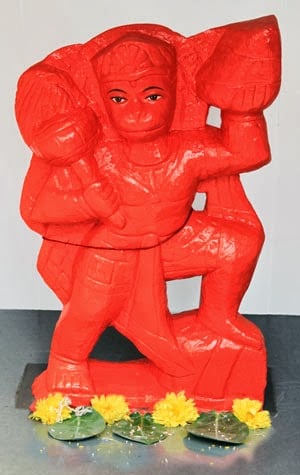
Hanuman : smeared with sindur (vermilion)
2. Once when Hanuman was proceeding to Lanka carrying the Dronagiri mountain, Bharat struck Him with an arrow and wounded His leg. This wound healed with the application of oil and sindur, hence Hanuman is fond of them.
Dasmaruti and Virmaruti
These are the two forms of Hanuman. Dasmaruti stands in front of Shriram with folded hands and tail on the ground. Virmaruti has the stance of a warrior. His tail is raised and His right hand is turned toward His forehead. Sometimes a demon is shown under His feet. Virmaruti is worshipped to overcome the ill-effects of negative energies.
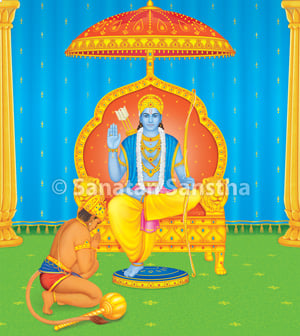
The five faced Hanuman (panchamukhi Hanuman)
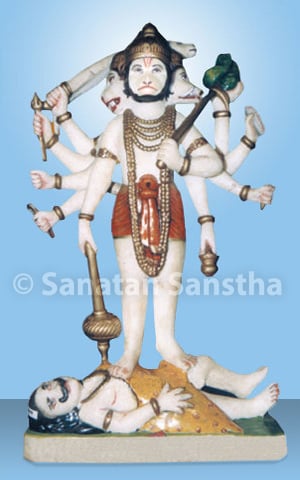
One comes across a number of five faced idols of Hanuman. These five faces are those of the eagle (garud), boar (varah), horse (hayagriva), the lion (sinha) and the monkey (kapi).This idol has ten arms, wields a flag, a human head, a sword and other weapons. A five faced Deity implies that it maintains vigilance and controls the five directions – North, South, East, West and the upward direction. Hanuman facing the south : Here, ‘south’ means the south direction and the right side.
Implied meaning of facing the southern direction
The face of the idol is towards the south, hence it is known as Dakshinamukhi (Dakshin= South, Mukhi= Face). One finds such Hanuman idols in the cities of Mumbai, Pune, Aurangabad, etc. in the state of Maharashtra and Basavgudi in Karnataka. Hanuman facing the right side is aggressive (emits energy), akin to Ganapati with His trunk pointing towards the right. Both these are worshipped in order to overcome the adverse effects of distressing energies. The Sushumna Nadi is always active in Deity Ganapati and Hanuman; but once Their form is changed, there are slight variations and accordingly either the Surya or Chandra Nadi gets activated to some extent.
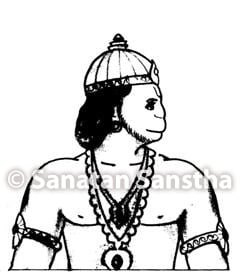 Hanuman facing the left-side |
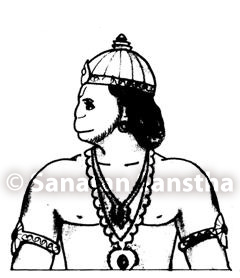 Hanuman facing south |
Shani (Saturn) and Hanuman
Although there is a firm belief among people about the relationship between Shani and Hanuman, its explanation is equally mysterious and beyond comprehension.
Similarity
1. In the Hanumantsahasranam stotra, Shani is mentioned as one of the thousand names of Hanuman.
2. The Suryasanhita mentions that Hanuman was born on a Saturday (Shanivar).
3. Rudra is one of Shani’s ten names.
4. Like Shani, Hanuman too is occasionally depicted as dark complexioned.
5. In Garhval where Shani is popular, Hanuman too is depicted as wielding an iron whip. Hence, unknowingly a similarity must have been established between Shani and Hanuman. Thus leading to worship of Hanuman on Saturday and the incorporation of this worship in the vowed observance on Saturday.
Dissimilarity
1. Shani is the son of the Sun Deity (fire element), whereas Hanuman is the son of the Wind Deity (air element).
2. There is discord between Shani and the Sun, whereas Hanuman is a devotee of the Sun. Hanuman has acquired all His knowledge from the Sun. The Sun has also imparted a hundredth fraction of its radiance to Hanuman. Due to discord between Shani and the Sun, the Sun helped Hanuman, who is considered to be Shani’s enemy. At that time, the air element and energy had not manifested completely in Hanuman.
3. Shani is slow, whereas Hanuman is swift like the eagle.
4. Shani is considered to be an evil planet. Hanuman is certainly not evil.
5. There is a custom of not selling oil on Saturdays, whereas there is a tradition of offering oil to Hanuman on Saturdays.
Yaksha and Hanuman
The Yakshas are described as brave and invisible. In the Valmiki Ramayan, Hanumant is addressed as the ‘invisible one’. Mahavir (The great valiant) is one of the well known names of Hanuman. It indicates the relationship between Hanuman and the worship of Yaksha. Hanumant finds a mention in the list of the fifty-two valiants, as Kapilumbir. At many places in Maharashtra, in the Hindu lunar month of Phalgun, processions of ‘valiants’ are on their way to worship Virmaruti.
Ganapati and Hanuman
Both are red in colour. Both possess ashtamahasiddhi(The eight great supernatural powers).
Importance of Hanuman as narrated by saints
Samarth Ramdas Swami has said, ‘Hanumant is our Deity’. Hanuman represents energy, skill and devotion. Hence, Saint Ramdas initiated the worship of Hanuman. The eleven Hanuman idols installed by Him are well known. In North India too, Saint Tulsidas established temples and gave importance to worship of Hanuman. Madhavacharya (founder of the Brahmasect, propounding duality) is considered to be an incarnation of Hanuman. Several other saints have also glorified Hanuman through Their compositions to set an example for society.
Hanuman Gayatri
आञ्जनेयाय विद्महे । वायुपुत्राय धीमहि ।
तन्नो वीरः प्रचोदयात् ।।
Meaning : We know Hanuman, the son of Anjani. We meditate upon Hanuman, the son of wind. May the valiant Hanuman inspire our intellect with Truth.
Hanuman in our lives
Only if Hanuman is present in each breath can we make Shriram [Jivatma (Embodied soul undertaking spiritual practice) or Atmaram (Soul principle)] dwell within us.

 Shri Hanumatstotram authored by Shridharswami
Shri Hanumatstotram authored by Shridharswami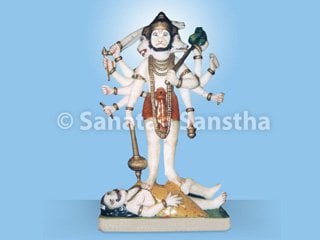 Panchamukhi Hanuman (Five faced Hanuman) – A Deity that imparts intellect, strength, fame, courage and...
Panchamukhi Hanuman (Five faced Hanuman) – A Deity that imparts intellect, strength, fame, courage and...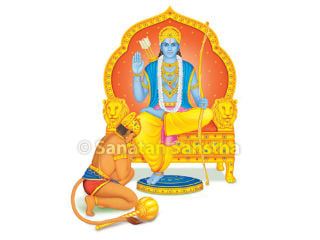 Hanuman – A supreme devotee proving the proverb ‘Greater than Ram is the Name of...
Hanuman – A supreme devotee proving the proverb ‘Greater than Ram is the Name of...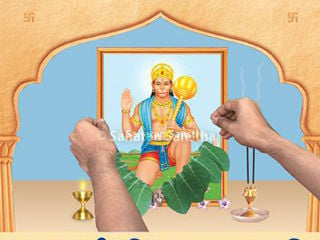 Worship of Deity Maruti
Worship of Deity Maruti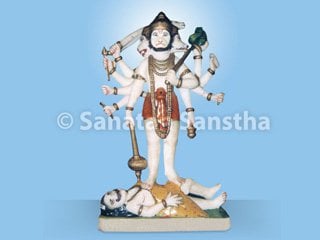 Science underlying the Idol of Deity Maruti
Science underlying the Idol of Deity Maruti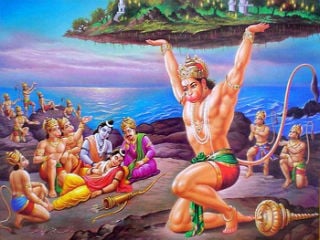 The courageous, intelligent, radiant and powerful Deity Shri Hanuman
The courageous, intelligent, radiant and powerful Deity Shri Hanuman